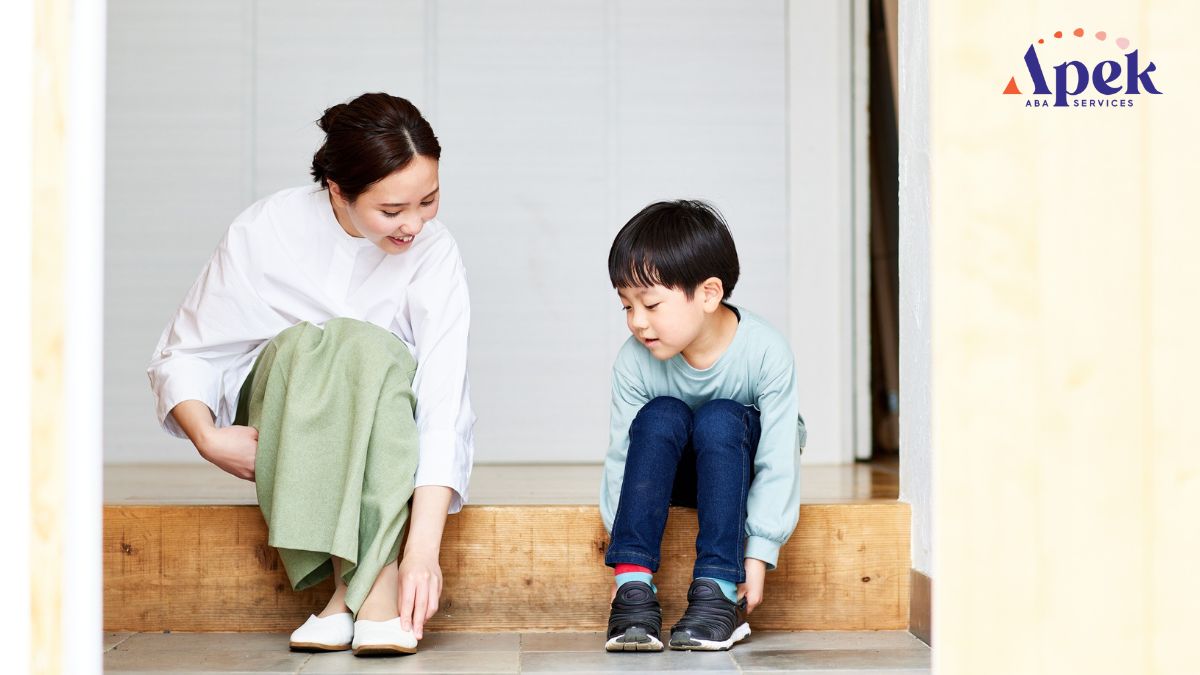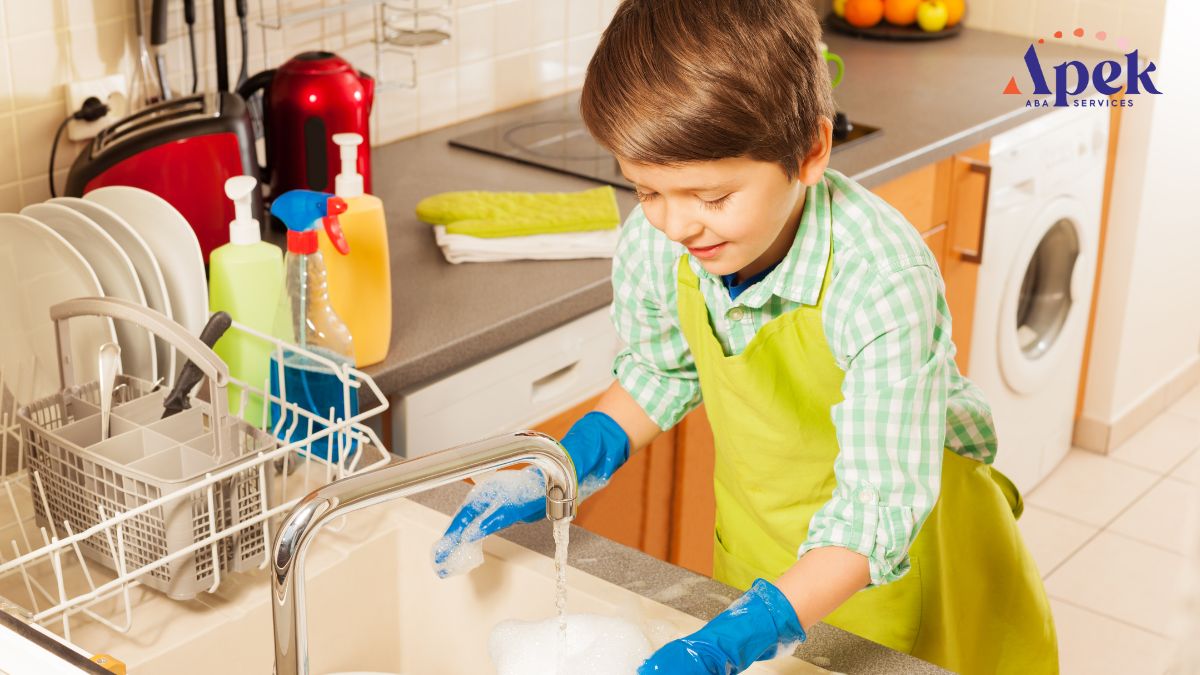Key Points:
- ABA therapy builds daily living skills by breaking tasks like brushing teeth, dressing, or meal prep into manageable steps, teaching with prompts, and reinforcing success.
- Skills are practiced across real settings until independence emerges.
- This structured approach boosts confidence, reduces family stress, and supports long-term independence.
Daily living skills form the foundation of independence. For children with autism, these skills do not always develop naturally. Simple activities like brushing teeth, getting dressed, or preparing a snack may feel overwhelming without structured guidance.
Applied Behavior Analysis (ABA) therapy provides that guidance. It uses evidence-based methods to teach and reinforce daily life skills in ways children can understand and apply in real life. ABA therapy life skills programs focus exactly on this need: teaching practical abilities that increase confidence and reduce reliance on others.
Daily Living Skills Defined: What Families Actually Need Help With
Daily living skills for autism cover the tasks that help a child function through the day. ABA therapy life skills targets these tasks because they connect directly to family stress and a child’s ability to participate at home, in school, and in the community.
Common areas include:
- Personal care: Toothbrushing, bathing, toileting, dressing, grooming, and menstrual care.
- Home and school routines: Morning and bedtime routines, packing a backpack, organizing homework, laundry, simple meal prep, and room clean-up.
- Health and safety: Handwashing, medication routines, kitchen safety, street crossing, and recognizing emergency signals.
- Community access: Riding in the car, using public restrooms, ordering food, and paying at a register.
- Self-management: Using checklists, timers, and planners; asking for help; and problem-solving when a step is unclear.
ABA therapy approaches daily living skills ABA therapy programs with one core idea: behavior changes fastest when the task is observable, measurable, and meaningful. Autism today affects about 1 in 31 U.S. 8-year-olds, so evidence-based support for daily living skills is essential for many households.

How ABA Teaches Daily Living
Progress on daily life skills in autism ABA depends on careful planning that feels simple to the child. Therapists break each task into small steps, give the right support, and reinforce success. Over time, support is reduced until the child can complete the skill independently at home, school, and in the community.
Key teaching tools work together:
- Task analysis: The therapist lists each step in order, such as “turn on water,” “wet toothbrush,” “apply toothpaste,” and “brush top teeth.”
- Prompting and fading: The plan starts with the least assistance needed (gesture, model, or light touch) and fades help as the child succeeds.
- Chaining: Teaching forward or backward links steps until the full routine runs smoothly.
- Reinforcement: The child earns access to a preferred item or activity after completing steps or the entire routine.
- Generalization: Practice moves from the clinic to the bathroom at home, then to school, so the skill shows up where it counts.
Where to Start: Selecting High-Impact Daily Living Goals
Parents want wins that reduce stress today and build capacity for tomorrow. Prioritize skills that unlock other routines or cut the most friction during the day. Therapy can start with one or two skills and expand as success builds.
High-impact choices:
- Toileting and hygiene: Gains here ripple across school readiness, peer acceptance, and health.
- Dressing and packing: Independent dressing and a consistent backpack routine shorten morning chaos.
- Meal routines: Simple prep, table setup, and clean-up build participation and pride.
- Safety habits: Stopping at curbs, walking with an adult, and answering safety questions protect the child outside the home.
When the team proposes goals, ask three questions. If yes, it belongs on the plan:
- Will this reduce daily stress?
- Will this increase independence in home or school routines?
- Will this skill still be valuable in three years?
Practical Programs That Work
Families benefit when therapy moves quickly from tabletop practice to bathroom, bedroom, kitchen, and community settings. Small wins accumulate when practice happens in the real place with the real materials and time of day.
Examples of ABA strategies across common routines:
- Toothbrushing: Use a laminated step list or picture schedule near the sink. Start with video modeling, then guided practice with prompts that fade over sessions. One study using an eight-session behavioral package increased independent brushing steps from 33.7% at baseline to 77.5% after training, with four children reaching 100%.
- Dressing: Teach one clothing type at a time. Backward chain the last steps first so the child experiences completion quickly, then add earlier steps. Use labels or color cues to find front/back and left/right.
- Bathing and showering: Break the sequence into short phases (prepare supplies, wash hair, wash body, rinse, dry). Use a waterproof timer for pacing and a simple song to cue step changes.
- Meal routines: Build a 10-minute snack routine first: wash hands, prepare two items, set a place, eat, wipe table, and put dishes in sink. Reinforce completion with a preferred activity.
- Laundry and room care: Start with sorting clothes into bins with photo labels, then add one machine step with a visual checklist. Pair clean-up with a “finished basket” so the child sees progress.
ABA teams keep sessions short and frequent. Three to five focused practice opportunities per routine, per day, often beat one long weekly attempt. Progress sticks when practice occurs at the same time each day, with clear visual cues and predictable reinforcement.
Adolescence and the Bigger Picture: Preparing for Adult Routines
Daily living skills drive long-term independence more than many academic targets. The adolescent years are the window to close the gap in self-care, household management, transportation basics, and personal organization.
Research highlights how far behind these skills can be in teens without an intellectual disability, often by 6 to 8 years, which can affect college readiness, vocational training, and first jobs.
High-value adolescent goals:
- Morning independence: Waking on time with a vibrating alarm, full hygiene routine, and an organized backpack.
- Money and food skills: Using a debit card with a spending limit, reading a simple recipe, and packing lunch.
- Transportation: Reading a schedule, using rideshare safely with caregiver monitoring, and following curb-to-door safety steps.
- Self-advocacy: Asking for help, communicating sensory needs, and following a personal check-in plan during stressful parts of the day.
ABA plans in high school should name adult outcomes and back-map the skills needed to reach them. Short practicums in school kitchens, laundry rooms, and campus stores create powerful practice time.
Build a Home Plan That Works: A 4-Week Starter Roadmap
Families can request a short, time-boxed plan that pairs clinic learning with daily home practice. The format below keeps goals tight and results visible.
- Week 1 – Define and set up: Choose one routine. Write the task analysis, gather visuals, and identify reinforcers. Practice each day in the real setting for five minutes.
- Week 2 – Teach and track: Start with the least intrusive prompt that works. Record independence per step. End each practice with the reinforcer, even if progress is small.
- Week 3 – Fade and generalize: Reduce prompts one level at a time. Move practice to a second setting or time of day once independence reaches 70%.
- Week 4 – Maintain and expand: Switch from continuous to intermittent reinforcement. Add one new step or a related routine, like handwashing before toothbrushing.
Share brief phone videos with your team so they can coach adjustments. If independence stalls under 50% on any step for a week, revise prompts or reinforcement before moving on.

Frequently Asked Questions
How to make living with autism easier?
Living with autism becomes easier through predictable routines, clear communication tools, and sensory-friendly environments. Visual schedules and checklists guide daily tasks, while adjusted lighting, noise, and clothing improve comfort. Shared planning, goal tracking, and collaborative support strengthen coping and independence in everyday life.
What are Activities of Daily Living skills?
Activities of Daily Living (ADLs) are self-care tasks like eating, dressing, bathing, toileting, continence, and moving between positions. Instrumental ADLs extend to cooking, shopping, money management, transport, and communication. Together, they identify support needs and guide therapy for safe, independent living.
What are life skills activities for autistic adults?
Life skills activities for autistic adults include meal planning with visual recipes, budgeting with checklists, and safety drills for kitchens and streets. Training also covers laundry, organization, public transport, shopping, and healthcare scheduling. Structured practice builds independence, work readiness, and confidence across real settings.
Start Building Routines That Last
Independence in daily living skills is one of the greatest gifts parents can give their children with autism. While the process requires patience and repetition, ABA therapy provides a proven framework for success. Children learn self-care, home routines, and community participation in ways that carry into real life.
By engaging in ABA therapy services in Georgia and Virginia, families can help their children improve daily living skills and reduce reliance on others. Apek ABA supports families through individualized programs that focus on practical skills every child needs.
Every child deserves the chance to grow in independence. Contact us today to start building stronger foundations for your child’s future.

